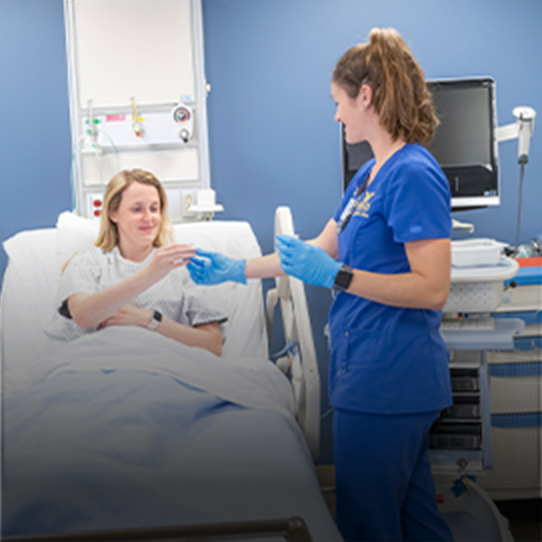The Benefits of Full Practice Authority for Nurse Practitioners

Since the creation of the role in the mid-1960s, nurse practitioners (NPs) have held a unique place in the world of health care delivery. They combine the best aspects of nursing care with clinical expertise in diagnosis, treatment and health promotion. The benefits of full practice authority for nurse practitioners are benefits that ultimately flow to their patients. NPs with full practice authority are able to exercise their best clinical judgment and expertise on behalf of their patients and communities.
The American Association of Nurse Practitioners (AANP), in a policy brief on the issue, defines full practice authority this way:
Full Practice Authority (FPA) is the authorization of nurse practitioners (NPs) to evaluate patients, diagnose, order and interpret diagnostic tests and initiate and manage treatments—including prescribing medications—under the exclusive licensure authority of the state board of nursing.
To understand the issues surrounding nurse practitioner practice authority, let’s look at some of the current responsibilities NPs have, some history surrounding the nurse practitioner role and why it is important to continue to advocate for full practice authority.

What Do Nurse Practitioners Do?
Nurse practitioners are advanced practice registered nurses (APRNs) who have received education at the master’s or doctoral level. NPs are certified in one or more specialty areas that are defined by their target patient population and, in some cases, by the patient’s level of acuity. Here is a list of NP specialty areas:
- Family Nurse Practitioner (FNP)
- Adult-Gerontology Acute Care Nurse Practitioner (AG-ACNP)
- Adult-Gerontology Primary Care Nurse Practitioner (AG-PCNP)
- Cardiac Nurse Practitioner
- Gerontological Nurse Practitioner
- Neonatal Nurse Practitioner (NNP)
- Oncology Nurse Practitioner
- Orthopedic Nurse Practitioner
- Pediatric Acute Care Nurse Practitioner (PNP-AC)
- Pediatric Nurse Practitioner
- Psychiatric and Mental Health Nurse Practitioner (PMHNP)
- Women’s Health Nurse Practitioner (WHNP)
Within those roles, nurse practitioners provide patient care with these services:
- Manage a patient’s care
- Order or perform diagnostic tests, such as lab work or X-rays
- Diagnose and treat acute and chronic conditions
- Prescribe medications and other treatments
- Offer counseling
- Refer patients to specialists and manage care transfers
- Educate patients on healthy lifestyle choices to prevent disease
The AANP says that 89.9% of nurse practitioners are certified in primary care, while 70.2% of NPs are actively delivering primary care. Delivery of primary care was the initial reason that the role of nurse practitioner was established and primary care remains a strong core of NP practice.
What Does Full Practice Authority for Nurse Practitioners Mean?
Since it was first created, the role of nurse practitioner has evolved in terms of what is considered accepted scope of practice. Because the NP role was an offshoot of the registered nurse role, it fell to state boards of nursing to codify the extent of NP practice. Exactly what NPs were allowed to do became a point of contention when the ability of NPs to diagnose illness and prescribe medications was seen as encroaching on the physician’s role. (In 1980, the Missouri state medical board sued two women’s healthcare NPs for practicing medicine without a license. The initial decision went against the two NPs but was later overturned by the Missouri Supreme Court.)
Nevertheless, in the intervening years, state boards of nursing have established laws regarding the scope of practice for all nurse practitioners. The AANP categorizes these practice and licensure laws into three groups:
- Full practice authority – These states allow all NPs to evaluate patients, prescribe medication, and manage treatment without any physician supervision.
- Reduced practice authority – These states limit at least one element of NP practice and require a nurse practitioner to enter into a collaborative agreement with a physician.
- Restricted practice authority – These states restrict at least one element of NP practice. This means the state requires the NP to be supervised by a. physician over the entire course of their career.
The following states, territories, and the federal district grant full practice authority to FNPs:
- Alaska
- Arizona
- Colorado
- Connecticut
- District of Columbia
- Delaware
- Guam
- Hawaii
- Idaho
- Iowa
- Maine
- Maryland
- Massachusetts
- Minnesota
- Montana
- Nebraska
- Nevada
- New Hampshire
- New Mexico
- New York
- North Dakota
- Northern Mariana Islands
- Oregon
- Rhode Island
- South Dakota
- Vermont
- Washington
- Wyoming
The following states and territories grant reduced practice authority to FNPs:
- Alabama
- Arkansas
- Delaware
- Illinois
- Indiana
- Kansas
- Kentucky
- Louisiana
- Mississippi
- New Jersey
- New York
- Ohio
- Pennsylvania
- Utah
- West Virginia
- Wisconsin
The following states grant restricted practice authority to FNPs:
- California
- Florida
- Georgia
- Massachusetts
- Michigan
- Missouri
- North Carolina
- Oklahoma
- South Carolina
- Tennessee
- Texas
- Virginia
In addition to the state practice authority requirements outlined above, the Department of Veteran Affairs (VA) declared in 2016 that nurse practitioners (and two other APRN roles, clinical nurse specialist and certified nurse-midwife) employed by the VA will have full practice authority regardless of any state-level restrictions.

Why Grant Full Practice Authority for Nurse Practitioners?
Let’s look at some of the reasons why full practice authority for nurse practitioners is in the best interest of patients and is an important way to promote equal access to health care.
NPs Can Fill the Primary Care Provider Gap
As physicians—especially primary care physicians—retire from healthcare positions, nurse practitioners can fill the gaps left behind. In 2020, the American Association of American Medical Colleges estimated that there would be a shortage of between 54,100 and 139,000 primary care and specialist physicians by 2033. An article from the Kaiser Health Network showed that the percentage of recent MD graduates choosing primary care residencies has declined from a high of just over 60% in 2011 to just over 40% in 2019. Compare this to the 70% figure for NPs delivering primary care.
NPs Can Help Remedy Shortages Exacerbated by the COVID-19 Pandemic
During the worst waves of the pandemic, several states relaxed scope-of-practice restrictions on NPs to get as many providers as possible in positions where they could provide care. While some of those waivers have expired, NPs demonstrated their ability to provide better patient outcomes cost-effectively.
NPs Can Help with the Opioid Crisis
Nurse practitioners in full practice authority states are more likely to apply for and receive a waiver that allows them to administer medication-assisted treatment (buprenorphine) to patients with opioid-use disorder. Moreover, an analysis of a dataset of 1.5 billion opioid prescriptions showed that NPs in states with less restrictive scope of practice wrote fewer prescriptions for opioids.
Patients Often Report Higher Satisfaction with NPs Versus Doctors
A 2019 review of survey responses from more than 50,000 patients compared patient satisfaction scores among nurse practitioners, medical doctors (MDs), doctors of osteopathy (DOs) and physician assistants (PAs) in primary care settings. The conclusion showed that patients rated nurse practitioners more highly than their colleagues.
NPs Can Increase Access to Primary Care in Rural Areas
A report written for the American Enterprise Institute states that primary care nurse practitioners were more likely to “practice in rural and underserved areas.” When this is evaluated against the fact that since 2000, the number of physicians practicing in rural areas has been decreasing while the percentage of NPs as a proportion of health care providers is growing, NPs can be a good match for rural populations. The same report also found that patients’ geographic access to health care was better “in states that did not restrict scope-of-practice compared to those that did.”
NPs Improve Patient Outcomes and Deliver Cost-Effective Care
Nurse practitioners consistently deliver care that is of comparable quality to that of physicians, with studies showing no statistical difference in patient outcomes between the two types of providers. Moreover, patients cared for by nurse practitioners have lower hospital readmission rates and fewer unnecessary emergency room visits, which translate into good cost containment.
How to Advocate for Expanded NP Practice Authority
Several organizations support full practice authority for nurse practitioners, most notably the American Association of Nurse Practitioners, the American Nursing Association and the National Association of Nurse Practitioner Faculties. Many states also have state-level nurse practitioner associations, which may have legislative advocacy committees and relationships with their state board of nursing.
Working for full practice authority has been a long journey, but perhaps this comment from Yale Associate Dean and Lecturer of Law Barbara J. Safriet, written in 1992, best sums up the need for immediate legislative reform to reduce the restrictions on advance practice nurses:
"Although our ailing health care system presents an endless array of symptoms, the diagnosis is relatively straightforward: too few people can get good care when they need it and at a price they can afford. Any proposed cure should therefore include, at a minimum, steps to eliminate …those things that impede the efficient and effective provision of health care…. Chief among these are conflicting and restrictive state provisions governing the scope of practice and prescriptive authority of Nurse Practitioners and Certified Nurse Midwives, as well as the fragmented and parsimonious state and federal standards for their reimbursement. As a result of these provisions, NPs and CNMs are severely hampered—or disabled altogether—in their efforts to fulfill their fully proven potential to enhance our nation’s health."

Find Your Path to Becoming a Nurse Practitioner
If you are considering becoming a nurse practitioner, your education will be a vital foundation for the role. Wilkes University has several online programs that are designed to meet your needs, no matter the point from which you are beginning your journey.
Each program offers you the option of three focus areas:
- Family Nurse Practitioner
- Adult-Gerontology Primary Care Nurse Practitioner
- Psychiatric/Mental Health Nurse Practitioner
Master of Science in Nursing (MSN) RNs with a BSN can undertake a program of online coursework, clinical placements and skills residencies to prepare you for advanced practice in the clinical, theoretical and professional aspects of your career as a nurse practitioner.
Registered Nurse (RN) to Master of Science in Nursing (MSN) Designed for current RNs who hold an Associate Degree in Nursing, this online program prepares you with clinical skills and professional role development, leading to certification as a nurse practitioner.
Post-Graduate/APRN Certificate. If you are an RN and already hold an MSN or Doctor of Nursing Practice (DNP) degree but want to earn certification in another focus area, this program can prepare you within three to six semesters, based on your previous coursework.
Wilkes University’s nursing programs are accredited by the Commission on Collegiate Nursing Education and have been ranked among the Best Regional Colleges by The Princeton Review and as a Military Friendly School.
Transition into a rewarding career as a nurse practitioner with Wilkes’ online Master of Science in Nursing (MSN) program, Registered Nurse (RN) to Master of Science in Nursing (MSN) program, or post-graduate/APRN certificate program. Get started by accessing your free program guide.




